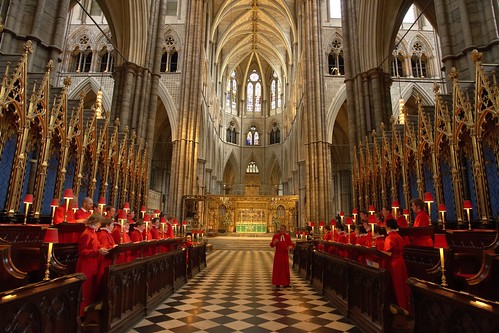25th June 2012
Ecumenism in action: Westminster Abbey in Rome

I was discussing ecumenism recently with a senior official of the Holy See. We agreed that while there is ongoing much useful discussion between representatives of different denominations – inter-Christian ecumenical dialogue has been one of the great fruits of the Second Vatican Council – there needed to be more “doing together” as well as talking together.
This week will see an extremely significant example of “doing together”. It sees the visit to Rome of the Choir of Westminster Abbey, one of the great choral ensembles of Europe, which last sang for Pope Benedict at the Abbey during the Pope’s extraordinary visit to the United Kingdom in September 2010. Pope Benedict was impressed, and the result is this return visit. The Abbey Choir will sing alongside the Sistine Chapel Choir, the Pope’s personal choir, for the celebrations of the solemnity of SS Peter and Paul in St Peter’s Basilica on 29 June. This will be the first time in its 500 year history that the Sistine Chapel Choir has joined forces in such a way with another choir. And may be the first time ever that a non-Catholic choir has sung at this most important of liturgies, when Archbishops from across the world will receive the Pallium from the Pope.
The development of the Anglican choral tradition is an essential element of Anglican patrimony. And an integral part of English culture. But it also links directly to the more ancient, Catholic roots of the Anglican tradition. By singing alongside the Sistine Chapel Choir, the two ensembles will explore their different traditions and development over the centuries. But they will also share what they have in common. It will be a live demonstration of the importance of culture as a bridge to cross historical divisions.
There is great symbolism in the visit. It is a further way of marking the United Kingdom’s appreciation for the strength of the bilateral relationship between my country and the Holy See that has flourished during Pope Benedict’s pontificate. That the Organist and Master of the Choristers of Westminster Abbey, James O’Donnell, is a Catholic, helps I think to show the important role of Catholics across British society, including at the heart of Anglican celebration. And the visit to Rome will end with an Anglican evensong in the church of Santa Maria Sopra Minerva, over which the English Cardinal, His Eminence Cormac Murphy-O’Connor will preside. This is “doing together” in action. Please do join us on the evening of 29 June, at 1900 at Santa Maria Sopra Minerva, if you can. All, of all faiths and none, are welcome.
I think it was amazing, because Westminster Abbey is fantastic place with particular holy ambience
So can anyone share how was it? It would be great to hear from someone who actually visited that event
I hope that this event will be televised because I think it is a beautiful thing for all of us to see. Gilad- Are you sure that this will be televised on EWTN? I heard that it won´t be on but maybe my resources are wrong?
Three in the morning and 5:30 pm, Eastern, on EWTN.
(Save the Liturgy, Save the World)
Would someone please present the adequate information for this event in St Peter’s Basilica, namely, at what time local time? Thank you.
it will be televised on EWTN this friday! As well on SiriusXM satelite radio this friday! What a great time in History to be Catholic!
I hope we have ear plugs for the times the Sistine Chapel Choir sings!In Italy every singer seems to be a prima donna. The Sistine Choir wiggle, move and take no account of a blending in with eachother. They are scruffy and need a good haircut! They use vibrato and lack self discipline! The Westminster Abbey Choir is fresh, has discipline and sounds very beautiful.
Lord be praised – how wonderful!
Check on EWTN – they might broadcast it (live or recorded)
How sad that neither event will be televised, at least according to the Vatican website.